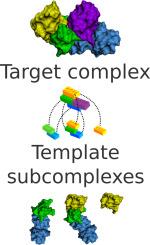DynBench3D, a Web-Resource to Dynamically Generate Benchmark Sets of Large Heteromeric Protein Complexes

Bertoni M, Aloy P, Multi-protein machines are responsible for most cellular tasks, and many efforts have been invested in the systematic identification and characterization of thousands of these macromolecular assemblies. However, unfortunately, the (quasi) atomic details necessary to understand their function are available only for a tiny fraction of the known complexes. The computational biology community is developing strategies to integrate structural data of different nature, from electron microscopy to X-ray crystallography, to model large molecular machines, as it has been done for individual proteins and interactions with remarkable success. However, unlike for binary interactions, there is no reliable gold-standard set of three-dimensional (3D) complexes to benchmark the performance of these methodologies and detect their limitations. Here, we present a strategy to dynamically generate non-redundant sets of 3D heteromeric complexes with three or more components. By changing the values of sequence identity and component overlap between assemblies required to define complex redundancy, we can create sets of representative complexes with known 3D structure (i.e., target complexes). Using an identity threshold of 20% and imposing a fraction of component overlap of <0.5, we identify 495 unique target complexes, which represent a real non-redundant set of heteromeric assemblies with known 3D structure. Moreover, for each target complex, we also identify a set of assemblies, of varying degrees of identity and component overlap, that can be readily used as input in a complex modeling exercise (i.e., template subcomplexes). We hope that resources like this will significantly help the development and progress assessment of novel methodologies, as docking benchmarks and blind prediction contests did. The interactive resource is accessible at https://DynBench3D.irbbarcelona.org.
Journal of Molecular Biology,
2018, 18, 30769
Pubmed: 30274705
Direct link: https://doi.org/10.1016/j.jmb.2018.09.011
